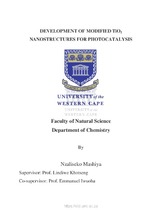| dc.description.abstract | TiO2 has been broadly used as a standard photocatalyst due to its high stability, low cost, relatively low toxicity, and excellent photocatalytic performance in comparison to other semiconductor materials. However, the large band gap of TiO2 limits its use as a photocalyst due to the high energy required for excitation of the electrons in the UV region. Research on the reduction of TiO2 band gap to the visible region of the spectrum has been explored with little success. Therefore, this study focusses on shifting the band gap of TiO2 catalyst from the UV region to the visible region by doping with graphene and nitrogen-doped graphene to form TiO2-G and TiO2-NG nanocomposites, respectively. The N-doped graphene support was prepared by doping the graphene oxide with nitrogen through Hydrothermal process, followed by the reduction of the materials.
Fourier Tranform Infrared (FTIR) spectroscopy confirmed the successful doping of graphene to N-graphene by the appearance of C-N and N-H vibrational modes on the spectra. The XRD results show the fingerprint patterns of TiO2 and N-graphene, which confirms the successful preparation of the nanocomposites. Morphological studies of the nanocomposites using transmission electron microscopy (TEM) show the TiO2 nanowires dispersed on graphene related supports. The optical band gap of TiO2 from UV-Vis spectroscopy was found to be 3.2eV, which decreased to 2.7eV and 2.5eV upon incorporation of grapheme and N-graphene, respectively. These results prove the success in the achievement of the aim in this study. When electrochemical studies were further conducted on the materials, TiO2-NG was found to possess better electrochemical properties with fast electron kinetics observed on the impendance spectroscopy results. The results obtained justified use of TiO2-NG photocatalyst the optimal material for organic mineralisation in Advanced Oxidation Processes (AOPs). | en_US |

